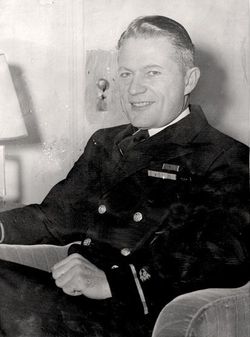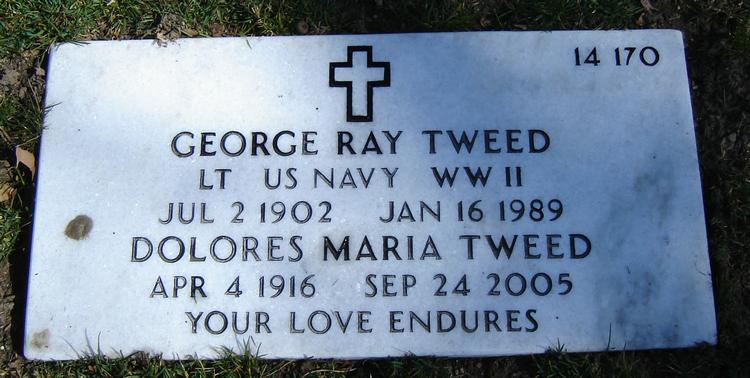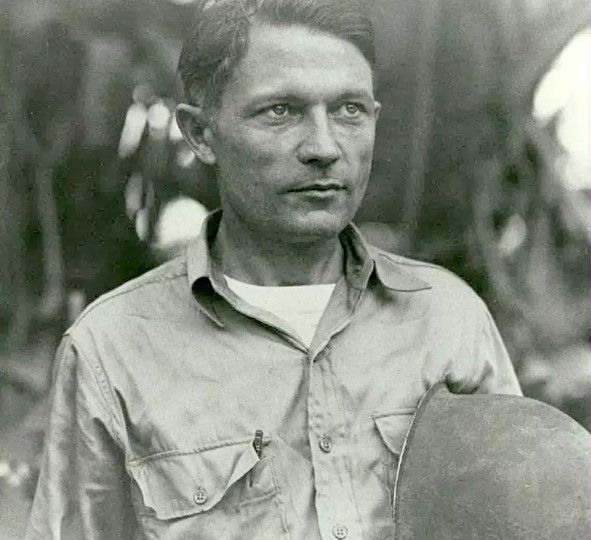George Ray Tweed
HOME OF RECORD:
Portland, Oregon
George Tweed was serving at Guam when it was attacked and quickly captured by Japanese forces, nearly all of his comrades being taken Prisoner of War. Among the few who escaped, most were subsequently captured and executed. George Tweed managed to evade the Japanese on that small island for two-and-a-half years, until he was subsequently recovered during operations to re-take Guam.
AWARDS BY DATE OF ACTION: 1 of 1
Legion of Merit
AWARDED FOR ACTIONS
DURING World War II
Service: Navy
GENERAL ORDERS:
CITATION:
The President of the United States of America takes pleasure in presenting the Legion of Merit with Combat "V" to Radio Electrician George Ray Tweed (NSN: 3927293), United States Navy, for exceptionally meritorious conduct in the performance of outstanding services to the Government of the United States while isolated on Guam following the seizure of that island by enemy Japanese forces on 10 December 1941, until rescued by an American Destroyer during the bombardment by our surface and aerial forces on 10 July 1944. Courageous and resourceful under relentless stalking by the Japanese, Radio Electrician Tweed succeeded in escaping capture and, with the aid of friendly and loyal natives managed not only to subsist during this prolonged, grueling period but to obtain much valuable information concerning the Japanese occupation of the Island. Ingeniously attracting the attention of an American Destroyer operating two miles off shore on 10 July, he subsequently signaled messages by semaphore, revealing information of an undamaged hostile battery of six-inch guns concealed at Point Adelup. After being rescued by our warship, Radio Electrician Tweed turned over a detailed log on enemy movements, troop concentrations, the results of our bombardment on hostile objectives beginning 11 June, and Japanese preparations to repel an amphibious landing, thereby making a vital contribution to the recapture of this strategic American possession. (Radio Electrician Tweed is authorized to wear the Combat "V".)
George Ray Tweed
HOME OF RECORD:
Portland, Oregon
George Tweed was serving at Guam when it was attacked and quickly captured by Japanese forces, nearly all of his comrades being taken Prisoner of War. Among the few who escaped, most were subsequently captured and executed. George Tweed managed to evade the Japanese on that small island for two-and-a-half years, until he was subsequently recovered during operations to re-take Guam.
AWARDS BY DATE OF ACTION: 1 of 1
Legion of Merit
AWARDED FOR ACTIONS
DURING World War II
Service: Navy
GENERAL ORDERS:
CITATION:
The President of the United States of America takes pleasure in presenting the Legion of Merit with Combat "V" to Radio Electrician George Ray Tweed (NSN: 3927293), United States Navy, for exceptionally meritorious conduct in the performance of outstanding services to the Government of the United States while isolated on Guam following the seizure of that island by enemy Japanese forces on 10 December 1941, until rescued by an American Destroyer during the bombardment by our surface and aerial forces on 10 July 1944. Courageous and resourceful under relentless stalking by the Japanese, Radio Electrician Tweed succeeded in escaping capture and, with the aid of friendly and loyal natives managed not only to subsist during this prolonged, grueling period but to obtain much valuable information concerning the Japanese occupation of the Island. Ingeniously attracting the attention of an American Destroyer operating two miles off shore on 10 July, he subsequently signaled messages by semaphore, revealing information of an undamaged hostile battery of six-inch guns concealed at Point Adelup. After being rescued by our warship, Radio Electrician Tweed turned over a detailed log on enemy movements, troop concentrations, the results of our bombardment on hostile objectives beginning 11 June, and Japanese preparations to repel an amphibious landing, thereby making a vital contribution to the recapture of this strategic American possession. (Radio Electrician Tweed is authorized to wear the Combat "V".)
Bio by: John "J-Cat" Griffith
Inscription
LT US NAVY WW II
YOUR LOVE ENDURES
Family Members
Other Records
Advertisement
See more Tweed memorials in:
Records on Ancestry
Advertisement












